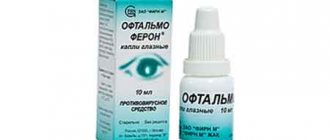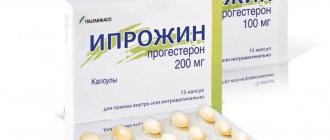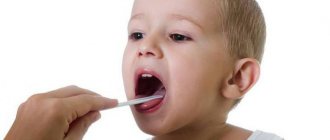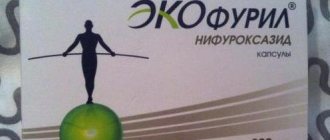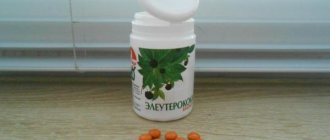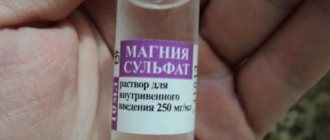Pharmacodynamics and pharmacokinetics
Pharmacodynamics
The hormone folliculin ( estrone ) is synthesized in women by the follicular epithelium of the ovary, from puberty to menopause . It affects the development of secondary sexual characteristics of the female type. follicles mature , the endometrium proliferates and the menstrual cycle is regulated. If the egg is not fertilized, under the influence of folliculin, the mucous membrane is rejected along with the unfertilized egg. The drug Folliculin contains a natural ovarian hormone obtained from the urine of animals or pregnant women.
Stimulates the development of the uterus when it is underdeveloped, eliminates disorders that occur in women during menopause due to insufficient ovarian function. Use with Progesterone regulates the menstrual cycle and reproductive function. In small doses, it stimulates the production of follicle-stimulating hormone , and inhibits it when used in large doses. Retains water and sodium in the body, improves glucose . It has nonspecific effects: it enhances reparative processes and epithelization of mucous membranes. Reduces blood cholesterol
Pharmacokinetics
Estrone is well absorbed, the required plasma concentration remains for 4–5 days. Metabolized in the liver. It is excreted in bile, and reabsorption occurs in the intestines and re-enters the liver. Ultimately, it is excreted by the kidneys in the form of conjugates . The rate of excretion largely depends on the condition (phases of the menstrual cycle, pregnancy ), as well as the age of the patient.
Folliculinum
Folliculinum (Folliculinum) is a homeopathic preparation made from one of the types of estrogen - the female sex hormone of the follicular tissues of the ovaries) - estrone.
The role of estrone is to promote the normal course of the first half of the menstrual cycle before ovulation:
- the hormone stimulates the growth and development of follicles and the eggs they contain, the maturation and growth of the endometrium (the inner layer of uterine tissue);
- has a tonic effect on other structures of the genital organs and enhances the secretion of cervical mucus to create favorable conditions for possible fertilization already in the second half of the menstrual cycle;
- at the same time, the woman’s emotional state improves.
This is interesting. Folliculinum has been used for about 30 years, relatively recently (in comparison, oral contraceptives began to be used more than 70 years ago).
Indications for use
Folliculinum is used for disorders leading to disruption of the ovulation process. These can be both psychological factors and organic health problems associated either with infection, or with reactive lesions of the reproductive and reproductive system, or due to diseases of other systems and organs. Folliculinum is used as part of complex therapy in the treatment of infertility.
Use of Folliculinum in the treatment of infertility
An integrated approach to the issue of infertility, taking into account all the symptoms, the patient’s constitutional type, heredity and medical history, allows us to approach the problem more objectively, to treat the body as a whole, and not just its specific organs.
The goal is general improvement, which in the future will help solve the problem of childbirth. An experienced homeopath combines and successfully uses in the treatment of both female and male infertility according to the scheme together with Folliculinum C200 - Carcinosin 200C, Sepia 6C, Thuja 200C, Medorrinum 200C. , Borax 30C, Natrum muriaticum 30C, Pulsatilla 12C, Nux vomica 30C and other drugs that also create optimal conditions for conception.
Folliculinum can be prescribed by a doctor to eliminate the undesirable consequences of irrational hormone therapy, long-term use of oral contraceptives and anabolic steroids. Source: flickr (Eugene Evehealth).
Psychological type Folliculinum
The main feature of the psychological type Folliculinum is oppression, oppression, whether physical, through physical violence or illness, whether psychological - difficult life circumstances, overbearing parents, spouse, colleagues, etc.
Such patients feel like debtors, are afraid of the prospect of not meeting someone’s expectations, try to please everyone even at the cost of their own health and dignity, overestimating their physical strength. They feel “like a squeezed lemon” and have a tendency to depression, melancholy, and emotional excitability. Prone to self-criticism.
Patients often do not have their own opinions and are easily influenced by others. At the same time, they feel constantly empty.
Properties of Folliculinum
Folliculinum promotes gentle natural recovery of the body, increasing vitality by restoring normal hormonal regulation of the body and enhancing biochemical processes during the restoration of damaged tissues.
This helps to normalize the hormonal function of the reproductive system during early or late puberty.
For diseases of the genital organs, it reduces inflammatory reactions, pain, the proliferation of papillomas, condylomas, and tumors. Strengthens local immunity.
The product mobilizes all restorative functions, promoting rapid recovery and a return to normal life after protracted illnesses.
Folliculinum helps to establish harmony in the emotional-volitional sphere in patients with the appropriate psychological type, improves mood, improves the ability to adequately assess the situation and calculate one’s own strengths, and helps increase self-esteem.
Indications for use
Folliculinum is used for the following diseases:
Contraindications
- Mastopathy;
- increased sensitivity;
- endometritis;
- neoplasms of the genital organs in women under 60 years of age;
- uterine bleeding and predisposition to it;
- hyperestrogenic phase during menopause ;
- liver failure;
- pregnancy;
- history of thrombophlebitis and thromboembolism
- age up to 14 years.
The drug is prescribed with caution for epilepsy , depression , arterial hypertension , and gallbladder diseases.
Hormone norm
In men, this indicator should vary between 3 – 6 ng%. For representatives of the fair sex, these indications vary depending on the menstrual phase and the onset of pregnancy:
- in the luteal phase, the minimum value of the substance can be 3 ng%, and the maximum - 25 ng%;
- in the follicular phase it ranges from 5 to 9 ng%;
- When pregnancy occurs, this figure increases from 1500 to 3000 ng%.
It is worth noting that the research method, as well as some of the normal indicators described above, may vary depending on the chosen medical institution and laboratory. Diagnostic centers indicate standards on their forms.
Folliculin, instructions for use (Method and dosage)
Folliculin solution is administered intramuscularly, after warming the ampoule in the hand. If crystals fall out, the ampoule is heated in a water bath for 15 - 20 minutes. The disappearance of crystals and their absence when the solution is cooled to 37°C indicates that the drug is suitable for use. During treatment, the minimum effective doses are selected.
For primary amenorrhea and underdevelopment of the genital organs, 10,000 - 20,000 units are prescribed every day for 1-2 months until the size of the uterus increases. Subsequently, Progesterone 5 mg daily is prescribed intramuscularly.
For secondary amenorrhea - 10,000 units every day for 15 days. The courses are repeated.
For oligomenorrhea , algomenorrhea , infertility against the background of decreased ovarian function, 5000-10,000 units are administered every day for 15 days after the end of menstruation.
In the menopausal period with severe symptoms ( angioneurotic phenomena , depression ) - 5,000-10,000 units every day, 10-15 injections per course.
If labor is weak - 40,000-50,000 units before the introduction of labor accelerating drugs. In all cases, a thorough gynecological examination is performed before starting treatment.
In what cases is research carried out?
This analysis is carried out when the following diseases appear:
- with dysmenorrhea;
- when planning artificial insemination;
- with oligomenorrhea;
- for problems with conception;
- with secondary as well as primary amenorrhea;
- when feminization occurs in men;
- for disorders of sexual development.
Elevated hormonal levels may indicate the following problems:
- about osteoporosis;
- about tumor processes in the ovaries;
- about thrombosis;
- about weight gain;
- about a malfunction of the thyroid gland;
- about polycystic ovary syndrome.
An increased level of this hormone also increases the chances of developing cervical and breast cancer.
A reduced amount of estrone indicates the appearance of the following ailments:
- insufficient functioning of the ovaries;
- problems with conception;
- reduction in the size of the mammary glands and uterus;
- about the absence of monthly cycles.
This study can be carried out in specialized medical institutions and centers.
Interaction
Folic acid and thyroid hormones enhance the effect of estrone , and antiestrogenic drugs , phenobarbital and rifampicin weaken it. Estrone enhances the effect of antiarrhythmic , hypocholesterolemic , antihypertensive drugs , anticoagulants, diuretics , glucocorticoids , antidepressants , thyroid hormones. Ampicillin , tetracycline , chloramphenicol , neomycin , sulfonamides reduce the concentration of the hormone in the blood , and ascorbic acid increases it.
Side effects of the substance Estrone
Uterine bleeding, dysmenorrhea, amenorrhea, premenstrual-like syndrome, increased size of uterine fibroids, vaginal candidiasis, changes in cervical secretion, pain, enlargement and discharge from the mammary glands, nausea, vomiting, cramping pain and bloating, cholestatic jaundice, myocardial infarction, pulmonary embolism , thrombophlebitis, cystitis-like syndrome, headaches, dizziness, depression, folic acid deficiency, megaloblastic anemia, etc., hypercalcemia (in patients with metastatic bone lesions), edema, chloasma, erythema (multiform, nodular), hemorrhagic rashes, hair loss, hirsutism, changes in libido.
Folliculin analogues
Level 4 ATC code matches:
Synestrol
Klimara
Colpotrophin
Proginova
Estrofem
Estrogel
Estriol
Divigel
Ovestin
Microfollin
Natural hormones - Estrone , Estradiol , Estriol ; esters of natural hormones - Estradiol valeriat , dipropionate , propionate - synthetic drugs - Mestranol , Ethinyl estradiol , Microfollin , synthetic drugs - Sinestrol , Diethylstilbestrol , Dimestrol Octestrol , Sigetin , Progynon , Telestrin , Telekinin .
Reviews about Folliculin
Preparations containing the natural hormone estradiol or estrone are used to stop juvenile bleeding in girls. Estrogen therapy is mandatory to maintain the female phenotype after hysterectomy in young women and girls. Natural estrogens have replaced Microfollin , which contains a high dose of synthetic ethinyl estradiol - 50 mcg. Hormone replacement therapy with natural estrogens has a full effect compared to microfollin , which allows its use for a long time.
There are not many reviews about the drug, which is due to its absence in the pharmacy chain. Judging by the reviews, it was most often used for dysfunctional uterine bleeding , amenorrhea associated with reduced function of the pituitary gland and ovaries. Hormonal therapy regimens for these diseases were different and included estrogens in combination with progesterone .
In case of a failed abortion (delay of a dead fertilized egg in the uterus), folliculin intramuscularly for 3 days to create an estrogen background, after which drugs that contract the uterus were prescribed. There are reviews of the drug confirming its effectiveness in the treatment of natural menopause and post-castration menopause (after removal of the ovaries).
“... Lately it has been impossible to buy ampoules of Folliculin, but I need it because I periodically take courses during menopause.”
Many patients note a local reaction to the administration of the drug in the form of tissue compaction, itching and rashes:
- “... I was in the hospital and injected with folliculin to prepare my cervix for childbirth. Now there are itchy pimples at the injection site.”
- “... All the women who were in the room with me after giving birth had painful lumps and itching after folliculin injections.”
Dysmenorrhea in women - what is it?
Algomenorrhea (algomenorrhea, dysmenorrhea) is a pathological process that cyclically repeats during menstruation, caused by a complex of metabolic, neurovegetative, and behavioral disorders. Translated from Greek, dysmenorrhea means “difficult menstrual flow.” A specific sign of dysmenorrhea is pain in the abdomen and pelvis, in rare cases radiating to the legs and sacral area. Severe pain signals a menstrual cycle disorder and can be accompanied by weakness, dizziness, and emotional outbursts.

